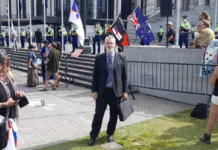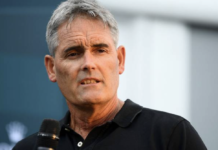
Announce protest actions, general chit chat or give your opinion on issues we haven’t covered for the day.
Moderation rules are more lenient for this section, but try and play nicely.
EDITORS NOTE: – By the way, here’s a list of shit that will get your comment dumped. Sexist language, homophobic language, racist language, anti-muslim hate, transphobic language, Chemtrails, 9/11 truthers, climate deniers, anti-fluoride fanatics, anti-vaxxer lunatics and ANYONE that links to fucking infowar.






Victoria University student dead for three days before he was found
https://www.stuff.co.nz/national/116300605/victoria-university-student-dead-for-three-days-before-he-was-found
Boo Hoo!!!
Sad sack Johnny Key may need to leave his cushy spot on a rouge ANZ bank.
https://www.odt.co.nz/business/john-key-may-have-relinquish-banking-role
Friday, 4 October 2019
John Key may have to relinquish banking role
Please, everyone. Lend me your tears, I can produce none myself.
What’s crazy is that the government are working on a global crisis every 200 years… I think it’s starting to be every few decades not every 200 years! aka global financial crash of 2007 – 2008, share market crash of 1987, oil crisis of 1973… what is new is that the banks are starting to cause it, due to governments deregulation of the industry and then the government prop banks up with taxpayers money that they don’t pay back. Crazy!
Even crazier is that the banks think every 200 years is too radical when it’s way too conservative based on actual global crisis that seem to be on the increase and caused by the financial sector greed and government not being interested in curbing it.
Banksy work depicting MPs as chimpanzees sells for record price
Devolved Parliament reaches just under £9.9m at auction at Sotheby’s in London
https://www.theguardian.com/artanddesign/2019/oct/03/banksy-work-depicting-mps-as-chimpanzees-sells-for-record-price
Well Save NZ,
Today in Gisborne finally ‘the waters broke’ on the eve of the ‘250 yr celebration of the meeting between Iwi and Capetian Cook.in Gisborne, as the Draft report of the restoration of our broken railway was leaked to the press.
Read all about it here and enjoy the moment of rejoicing with us all.
Subject: News flash from Gisborne. – Signs study will favour rail line link
News flash from Gisborne.
Subject: GH
gisborneherald.co.nz
Signs study will favour rail line link
by Wynsley WrigleyPublished: October 4, 2019 1:45PM
A feasibility study due out in draft form this week looks likely to favour reinstating the Gisborne-Wairoa rail line.
That is East Coast National MP Anne Tolley’s understanding. She says the Provincial Growth Fund-backed study shows that the deal “possibly now stacks up to reinstate the Gisborne to Wairoa section for freight”.
Progress of rail study
Business and economic research group Berl started work on a feasibility study looking at the possibility of reinstating the Gisborne to Wairoa rail line in June.
Unlike previous studies this study would also take into account wellbeing factors, rather than just a traditional cost-benefit monetary analysis.
Berl deputy chief economist Hillmare Schulze said last month the study had progressed and was expected to be completed before the end of the year.
“The majority of the field work is complete and we have moved on to the analysis and drafting. We have engaged with local businesses, freight forwarders, industry groups and rail tourism interests to understand the demand for rail and are considering a range of options for the future of the line.
“In terms of community engagement. Engagement with local communities has been central to the study from the outset. We have had strong engagement with the local communities in Gisborne, Wairoa and right along the railway line.
“Rather than an open call for public submissions, we have carried out targeted engagement with stakeholder groups or their representatives. This has included whanau, hapu, iwi, trusts, incorporations, community groups, businesses and business groups, council officials and elected representatives.”
Mrs Tolley told The Gisborne Herald she was interviewed for the feasibility study last month.
The study, being conducted by BERL (Business and Economic Research Ltd) has a wider scope, including the impact of trucks on the highway, than previous feasibility studies.
Mrs Tolley said the rail line would need major investment.
“The line would certainly build in some resilience for our southern access to markets given the nature of our country and the difficulty we have keeping our roads up to scratch,” she said.
Ikaroa-Rawhiti Labour MP Meka Whaitiri said National’s interest in the rail line was “in stark contrast to the nine years they had the budget to do something but chose not to”.
“Let me be clear, this rail link is an important kaupapa for our community, and we need to take the time required to get it right the first time.
“That’s why this Government is undertaking a feasibility study, with a draft report due by October 1 and the final report back by December 13.”
Mrs Tolley said a significant period of time had passed since the last rail feasibility study was completed.
“A lot has changed since then.
“At the time of the storms that washed out the line in 2014, KiwiRail wasn’t very interested in the East Coast.
“I spoke to businesses that hadn’t seen anyone trying to increase use of the line for years.”
Three trains a week was insufficient for food producers who needed immediate and regular container access to markets.
“Despite the developing squash product, which was being freighted on the line, I couldn’t make an economic case to repair the line.”
But Gisborne now had a growing and lucrative apple industry, shipping out of Napier Port.
The district also had a growing kiwifruit industry and with increased production would soon need to see investment in local coolstores.
Mrs Tolley also noted that Gisborne had a new sawmill “probably producing a trainload of processed wood a day”.
The other big change was that Treasury now allowed the impact of trucks on roading infrastructure to be included in their business case and rate of return on investment calculations.
“It’s a critical calculation that makes a big difference,” Mrs Tolley said.
“In every economic study I’ve taken part in as the local MP, and there have been quite a few, I have repeatedly pointed to our fertile flats.
“We are now seeing some of that potential realised with more diversified and intensive horticulture and more products needing quick and reliable access to port facilities.
“The only impediments I’ve been made aware of are water, reliable transport links, and staffing.
“So, do we need a rail service that links Gisborne to the Napier Port, and the main trunk line via Napier and Palmerston North?
‘Has to be daily, reliable’
“Can we trust that our taxpayer subsidised monopoly called KiwiRail will provide the everyday, reliable service our producers need and would use.
“Any half decent business that has been running persistent losses for years should be out looking for new customers, knocking on doors, making service promises and signing up business.
” Where are they?” Mrs Tolley asked.
“They got as close as Wairoa to open that southern piece of the line.
“Did anyone come north to check out our potential?
“That is now the critical piece of this never-ending equation – it has to be a daily service and it has to be a reliable service.
“We need KiwiRail to hunger for our business to make it work, or be prepared to get out of the way and let private enterprise take over and run it to make it work for us and them.”
Meka Whaitiri said Mrs Tolley’s critique over the need for, and quality of, the rail link project “ignores the fact that ensuring the best outcome for our community is exactly what a feasibility study is designed to explore”.
She said the study had been tasked with examining the reinstatement of part or all of the Gisborne to Wairoa line. It would also look at proposals for different kinds of uses including rail freight, rail tourism, and other types of tourism; and the mix of compatible uses for the rail corridor that would maximise its commercial viability.
“Our community has already seen concrete proof of this Coalition Government’s commitment to investing in our regional infrastructure, creating local jobs for local people and boosting our businesses through greater access to external markets,” said Ms Whaitiri.
“I expect this rail link will further revitalise our region – which was neglected by the last lot – and follow in that proud tradition.
“Tairawhiti Rail Ltd’s local knowledge and skills, KiwiRail and New Zealand Transport Agency are among those whose expertise is involved in the creation of this report.
“I join the rest of our community in supporting their mahi, and awaiting their feedback on how we can best maximise this long ignored opportunity to get our region’s future back on track.”
Broader outlook of study pleases action group Reinstatement of the Gisborne rail line “deal” stacked up earlier than MP Anne Tolley’s announcement, says the Rail Action Group.
Spokeswoman Gillian Ward said Mrs Tolley, as the local MP and formerly a cabinet minister, could “perhaps” have had some influence in encouraging the Government to repair the line in 2012 after the washouts.
“However, with the National Government ideologically opposed to investing in the rail network, Tairawhiti was instead given $4 million in 2013 to be spent on a few passing bays on State Highway 2 – very disappointing.”
In 2011, after KiwiRail had modernised the Napier-Gisborne line to make it able to carry the new “hi-cube” 40 foot containers, rail freight was increasing, said Ms Ward.
From December that year, Weatherell Transport Ltd was loading a trainload of up to sixteen 40 foot containers, of fresh produce each day.
“The produce was chilled overnight and one train per day went directly to Napier’s export container port, saving heaps for local growers.”
Steve Weatherell, working as the freight forwarder, was the local KiwiRail agent and with effective marketing and efficient freight handling, the future for the line was looking encouraging, said Ms Ward.
But the line only had four months to prove itself.
The cost to repair the line was estimated to be $4 million in 2012, but the government required KiwiRail to justify the cost of the repair on strictly commercial terms and the decision was made to not repair the line.
“If time had been granted for more companies to come on board and the freight to increase, and with a broader consideration including transport resilience, economic and environmental benefits, safety and maintenance on State Highway 2, tourism value, and social connectivity with passenger services, a different decision would very likely have been reached.
“The current feasibility study, funded by the Provincial Growth Fund has this broader outlook, and we hope that when the government receives this
(draft) report this month, a decision will be made to repair the line between Gisborne and Wairoa.
“As Mrs Tolley notes, there is a huge expansion in horticulture taking place, and there would now be sufficient freight for one train per day throughout the year, and extra during the main produce season.
“Mrs Tolley’s cautious positive comments are appreciated,” said Ms Ward.
Simon Bridges, represented in his rogue MP’s reports as mustelid in his manoeuvering ( which I don’t think any poly is removed from) seems determined to follow the OZ model that just delivered them to an unexpected victory. Except he has a conscience. That’s the problem with our Right. But it’s as simple enough as someone coming along without said. And ,like every where else, the jawless wonders will chase the fantasising psycho. Of course it’ll be against everything NZ, our reticence.
Ann Tolley all about last century measurements of roads okay rail has to be justified by cost. It will need to entirely flip over in areas like Gisborne. The rail gets put in and the road is tolled. Or the like, the hubodometers can go up per km. We Cannot afford to go on building roads as we have been.. And that is apart from CC considerations. So all that prudent stuff from National is a mask to hide behind.. The trouble with NZ is that a only a few people are prepared to learn how to swim; the rest sit in warm spa pools and socialise. We have got to the stage where they will have to be eschewed, and we learn how to swim and when we have to we can dive in the deep end, and come up smiling.
Comments are closed.